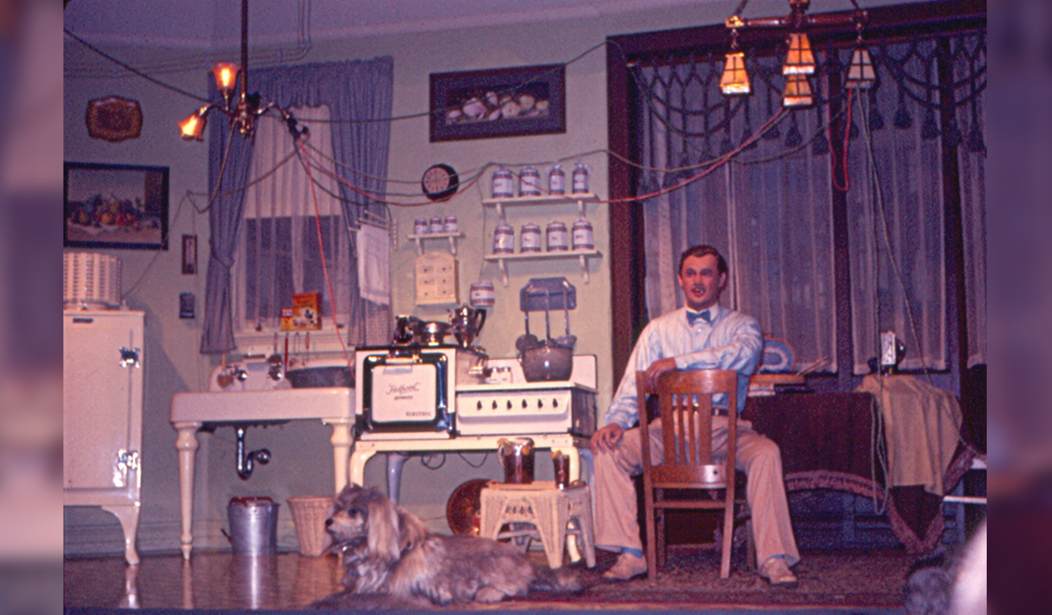In case you’ve missed the rest of the series:
Part 1: ‘The Kind Of Service We Can Offer’
Part 2: ‘Something No One Has Seen Or Done Before’
Part 3: ‘I Won’t Open The Fair Without That Exhibit!’
Welcome back to our series where we’ve looked back at the 50th anniversary of the 1964-65 New York World’s Fair and Disney’s input into it. This week, we’ll see how Disney teamed up with one of the country’s most recognizable corporations to create a pavilion that celebrated American ingenuity and free enterprise.
In Disneyland’s early days, Walt devised the idea for a side street offshoot from Main Street, U.S.A. At the Edison Square attraction, Disney would team up with General Electric (which had its genesis in Edison’s company) to present the story of how electricity benefited a typical American family from the turn of the 20th century, through the present, and into the future. Disneyland’s souvenir maps listed Edison Square among the park’s coming attractions, but by 1959, General Electric (GE) requested that Disney use their idea in a pavilion at the forthcoming World’s Fair in New York City. They called the exhibit General Electric Progressland.
GE knew they had partnered with the right organization, and their promotional materials for the Fair touted Walt’s involvement:
Walt has used all his resources to make Progressland the number one attraction at the Fair. He has filled it with surprising, often startling, and always pleasing evidences of his great ability to entertain.
But the purpose is never lost sight of — to tell the story of electricity and the way it is changing the world — past, present and future . . . to showcase a great industry, the electrical industry, and tell how it has grown and prospered (and helped the nation to grow and prosper) in a free, competitive society.
Progressland – which, as GE boasted, was located “at the intersection of Commerce and Progress Avenues” – featured several exciting exhibits. After guests entered through a dazzling hall of mirrors, the Skydome Spectacular, where a “sequence of thunder, lightning, solar flares, and spinning atoms” awaited them. At the end of the ramp that led down into the show space, visitors witnessed the “first demonstration of controlled thermonuclear fusion to be witnessed by a large general audience” every six minutes. Following a dramatic countdown, a loud report and vivid flash let guests know that the fusing of deuterium atoms at 20 million degrees Fahrenheit had taken place.
The Medallion City exhibit allowed visitors to see a couple dozen tableau of innovations in electric appliances and utilities that purported to demonstrate all-electric living for the near future – using GE products, naturally. The Toucan And Parrot Electric Utility Show blended Audio-Animatronics and animation to humorously discuss the state of electricity between the 1939 and 1964 World’s Fairs. On the outside of the pavilion, the roof glowed with dancing lights. In the evenings, a beautiful fountain and fireworks show helped make Progressland one of the most popular attractions at the Fair.
But the centerpiece of the pavilion was Walt Disney’s brainchild, now called the Carousel of Progress. Instead of the walk-through theaters of the original Edison Square concept, guests to the Carousel of Progress sat in a round theater which revolved past central stages in which an Audio-Animatronic narrator shared how his family benefited from new electric innovations. (One gossip columnist lamented the fact that she discovered that the show’s narrator was not a real man.) Each of the show’s short acts took place in different decades, from the 1890s to the 1960s. In all, Imagineers designed and built 32 animatronic characters for the show all bearing Walt’s inimitable stamp.
Walt summoned his go-to songwriters, Richard and Robert Sherman, to pen the perfect tune for the Carousel of Progress. The song had to represent a positive vision for the future, yet it had to be adaptable to the time periods that the show presented. Richard Sherman remembered that the song needed to “tell the story without giving away what’s happening,” while epitomizing “the spirit and the essence of that pavilion.” The result was “There’s A Great Big Beautiful Tomorrow,” a bouyant song that summed up the ideas that Progressland espoused. Buddy Baker arranged the song expertly to fit each era of the Carousel of Progress.
Interestingly enough, GE requested a change to the song in 1974, expressing the thought that the present was more important than the future. The Sherman Brothers wrote a tune called “The Best Time of Your Life” for the Carousel of Progress, but Disney restored the more optimistic “There’s A Great Big Beautiful Tomorrow” in 1994. “There’s A Great Big Beautiful Tomorrow” also appeared in an instrumental theme at Epcot’s Horizons attraction, which GE also sponsored. Of the song, Richard Sherman said:
In a way, it was Walt’s theme song, because he was very positive about the future. He really did believe that there was a “Great Big Beautiful Tomorrow” shining at the end of every day.
Progressland was one of the bona fide hits of the 1964-65 World’s Fair. Visitors often waited over an hour to enter the pavilion, even though 200 guests could enter every four minutes. The Carousel of Progress opened at Disneyland in 1967, and Disney moved the show to Walt Disney World in 1975, where it remains to this day. Though guests tend not to visit it much, Disney denies the near constant rumors that the Carousel of Progress is in danger of closure.
On our family trip last fall, we took my nieces – ages 4, 5, and 8 at the time – to see the Carousel of Progress for the first time. We didn’t expect them to enjoy it, but we went for the respite from the heat as well as the nostalgia for us adults. All three girls remarked how much they enjoyed the attraction. I guess there’s something timeless about Walt’s optimistic futurism after all.










Join the conversation as a VIP Member